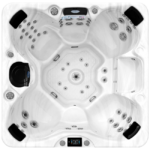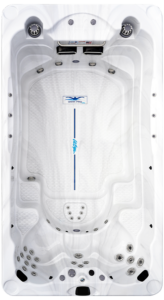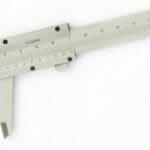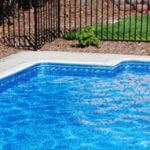vinyl liners
When talking about the “mil” or “guage” of vinyl pool liners, you should first get a decent understanding of what these terms actually mean. The most common term for vinyl, “mil” (not to be confused with millimeter) is a unit of measurement equal to one thousandth of an inch. Therefore, a 20 mil liner thickness is equal to 20 thousandths of an inch. The term “gauge” (not to be confused with mil), is a bit more of a moving target. See, multiple industries measure items such as wire, shotgun barrels, sheet metal, photographic film and hypodermic needles by their gauge. This can be very confusing as in a case like shotgun barrels where the smaller the gauge, the larger the barrel. This is not the case when it comes to vinyl pool liners where the higher the gauge, the thicker the material.
When shopping for pool liners, it is very important that you are aware that gauge is not equal to mil. Some manufactures or retailers like to offer their liners in terms of gauges because they sound thicker than a true mil. To be technical, a 30 mil liner is equivalent to 0.0300 inches. A 30 gauge liner is equivalent to 0.0260 inches (26 mil). Therefore, if you see a liner advertised at 35 gauge, it is truly a 30 mil liner. To avoid this confusion, always make sure and purchase from a company that advertises in mil, versus gauge.
To give some additional perspective, here is the mil of some everyday items:
| Item | Thickness (in mils) |
| Standard sheet of paper | 10 mil |
| Dime | 49 mil |
| Human hair | 2 mil |
When deciding what’s best between the thicknesses of vinyl pool liners for in ground pools, a variety of factors should be considered. Such as the location of the pool in relation to sun exposure, how much time the pool will spend covered and the type of surface the liner will be laid on.
If the pool will experience longer exposure to direct sunlight throughout the year or when you’re dealing with a rougher surface material, such as a concrete or a sand and concrete mixture, the appropriate, preferred mil of vinyl pool liner would be the 28-30 mil. Although thicker material will typically cost you about 5 – 10% more, it is 29 – 32% thicker than 20 mil, and will no doubt provide adequate thickness and protection for its purpose.
With that being said, all pool liner material, no matter the thickness will boast the smooth nature vinyl is famous for, come in an array of patterns to choose from, and in most cases, carry the same warranty.
Continue ReadingWater Chemistry
Your liners life and looks depends on an accurate water balance. Keeping proper pH levels will help maximize your chemical’s full potential such as the ability for chlorine to kill algae and bacteria.
Learning the proper technique for water testing is essential. Our sales staff will be glad to show you how and can supply you with the needed testing kits. Always follow the manufacturer’s documentation for your safety and the safety of your family and friends.
In-Season Chart
| In-Season Chart | |||
| Factor | Range | Test Frequency | Function |
| pH | 7.2 – 7.60 | Daily | Allows other chemicals to operate properly |
| Free Chlorine Residule | 1.0 – 1.5/ppm* | Daily | Kills bacteria |
| Total Alkalinity | 60 – 125/ppm* | Weekly | Ability of pool to counteract change in pH |
| Cyanuric Acid | 30 – 75/ppm* | Monthly | Stabilizes water chemistry |
| Calcium Hardness | 175 – 250/ppm* | Monthly | To avoid corrosive conditions in pool systems |
|
*ppm = parts per million |
|||
pH Level
pH Levels are the acidity or alkalinity of pool water on a scale of “0- 14”. The extreme acid is “0” and the extreme alkali is “14”. Proper pH range is 7.2-7.8. pH readings above 7.8 will lead to scaling on all pool surfaces and cloudy water, inefficient sanitizing, and swimmer discomfort. pH readings below 7.2 will lead to corrosion of metal parts such as heaters and ladders, wrinkled vinyl liners, and swimmer discomfort.
Chlorine
Chlorine will do the job of killing the bacteria in the water if the circulating range of 1.0 – 1.5 ppm is maintained. Anything above this range will attack the liner, bleaching it and shorten its life. Below this range may not kill the bacteria causing unhealthy conditions and possible unsightly staining to your investment.
Letting granular chlorine come into contact with the liner before it has fully dissolved will also damage your liner. To avoid this, dissolve it first in a bucket of water, and pour it in various locations around the pool. This technique is also used with liquid chlorine.
Never mix chemicals together as this may cause personal harm, instead add chemicals to the pool water separately and circulate throughout pool before adding second chemical. Circulation can be achieved by sweeping your pool.
Automatic Pool Sweeps and Maintenance Equipment
It is very important that you only use vacuum head, pool sweeps, brushes or other maintenance equipment that have specifically been designed for your vinyl liner pool. Never use the telescopic pole in the pool without the attachment, the pole is very sharp and may damage the liner.
Vinyl Liner Repair
Should your liner receive a cut or tear, it can usually be repaired using specialized products for vinyl pool liner repair. These adhesives are made to work above or below the water line. Ask your Secard Pool Sales consultant for correct repair procedure and products available.
Water Level
Always keep the water level up to allow your skimmer to operate as designed. Allowing you pool’s water level to fall below this can cause the liner to shrink causing tears and cracks. The water actually holds the liner in place. Never drain your pool, consult with your pool man first!
The Water Line
To reduce grime build up and ultra violet deterioration, a good, non-alcohol, non-petroleum based vinyl protective liquid applied to a clean vinyl surface will work. Please Ask one of our sales associates to help you select a product specially suited for this use.
Continue Reading





